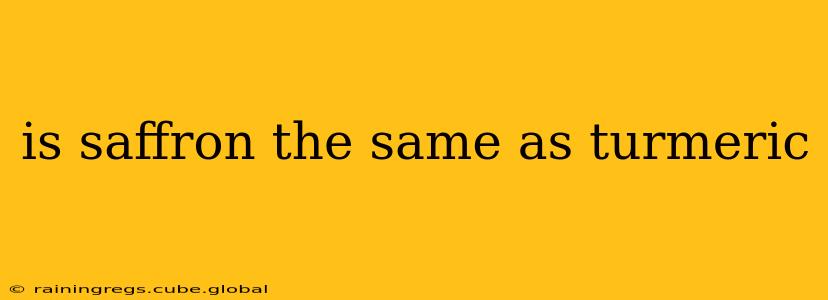Is Saffron the Same as Turmeric? A Deep Dive into Two Vibrant Spices
Saffron and turmeric are both vibrant spices prized for their color and purported health benefits, leading many to wonder if they are the same. The short answer is a resounding no. While both are derived from plants and offer distinct culinary and medicinal uses, they are vastly different in origin, appearance, taste, and chemical composition. This article will delve into the key differences, clarifying any confusion and highlighting the unique attributes of each spice.
What is Saffron?
Saffron is derived from the Crocus sativus flower, specifically from its stigma (the female part of the flower). Each flower yields only three stigmas, which accounts for its exceptionally high cost, earning it the title of the "world's most expensive spice." The stigmas are carefully hand-harvested and then dried, resulting in the characteristic reddish-orange threads we recognize as saffron. Saffron has a distinct, slightly bitter, and intensely aromatic flavor with earthy and slightly sweet undertones.
What is Turmeric?
Turmeric, on the other hand, is derived from the rhizome (underground stem) of the Curcuma longa plant. This rhizome is harvested, cleaned, and then typically dried, ground into a powder. Unlike saffron's delicate threads, turmeric powder is a deep golden-yellow to orange-brown color. Its flavor is distinctly earthy, slightly bitter, and with a warm, peppery note.
What are the Key Differences Between Saffron and Turmeric?
The differences between saffron and turmeric go beyond their visual appearance. Here's a breakdown:
- Origin: Saffron comes from the Crocus sativus flower's stigma, while turmeric comes from the Curcuma longa plant's rhizome.
- Appearance: Saffron is comprised of delicate, reddish-orange threads, whereas turmeric is a fine golden-yellow to orange-brown powder.
- Flavor: Saffron possesses a unique, slightly bitter, earthy, and aromatic flavor profile, while turmeric offers an earthy, warm, slightly peppery, and bitter taste.
- Cost: Saffron is significantly more expensive than turmeric due to its labor-intensive harvesting process.
- Active Compounds: Both spices contain various bioactive compounds, but these differ significantly. Saffron is known for its crocin (responsible for its color and some of its health benefits), picrocrocin (contributing to its bitter taste), and safranal (responsible for its aroma). Turmeric's primary active compound is curcumin, a potent antioxidant with numerous purported health benefits.
What are the Uses of Saffron and Turmeric?
Both spices find applications in culinary and medicinal contexts:
- Saffron: Primarily used as a flavoring and coloring agent in dishes, particularly in Middle Eastern, Mediterranean, and Asian cuisines. Its delicate flavor and vibrant color enhance rice dishes, stews, and desserts. It's also sometimes used in traditional medicine.
- Turmeric: Widely used in Indian cuisine as a key ingredient in curries and other savory dishes. It also plays a significant role in Ayurvedic medicine, with many attributing various health benefits to its curcumin content.
Are there any similarities between saffron and turmeric?
While vastly different, both saffron and turmeric:
- Are potent antioxidants: Both contain compounds with antioxidant properties, contributing to their potential health benefits.
- Offer potential health benefits: Although research is ongoing, both are associated with various health benefits, ranging from anti-inflammatory effects to potential cognitive improvements. However, it's important to note that more research is needed to definitively confirm many of these claims.
- Provide vibrant color to dishes: Both spices add a distinctive and appealing color to food.
In conclusion, while both saffron and turmeric are valuable spices with unique properties, they are not interchangeable. Understanding their distinct origins, appearances, flavors, and active compounds allows for a greater appreciation of their individual culinary and potential medicinal uses. Choosing between them depends entirely on the desired flavor profile, color, and intended application.
